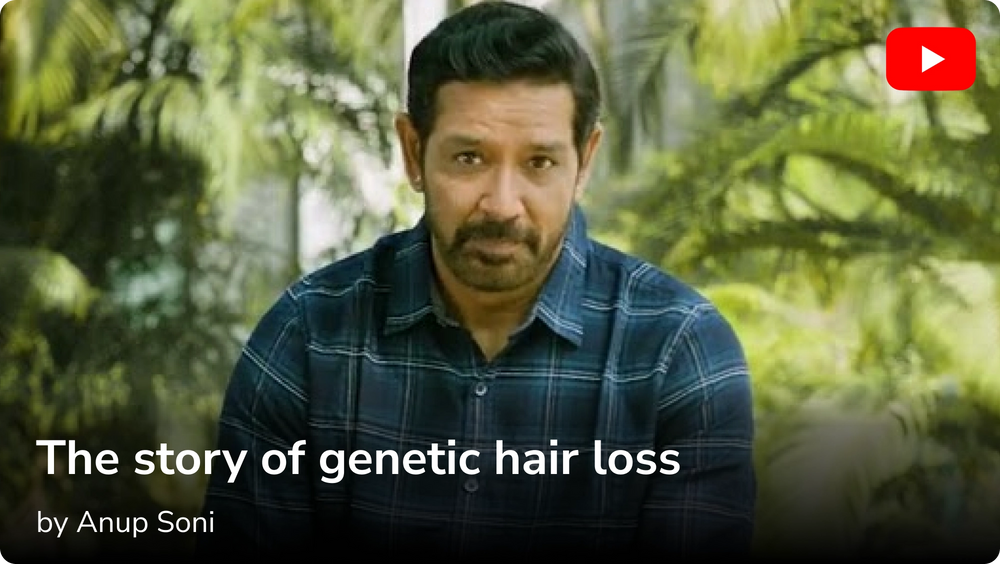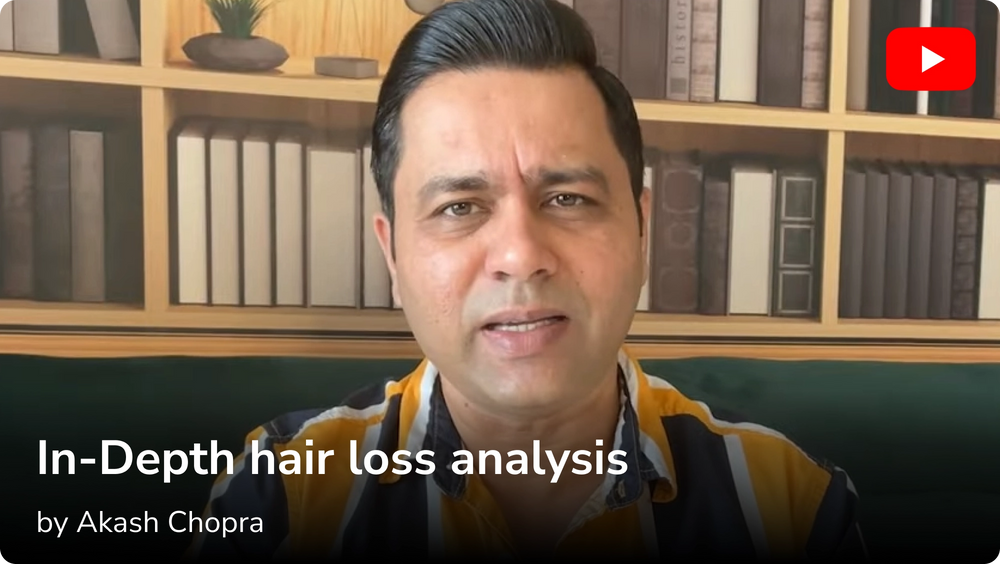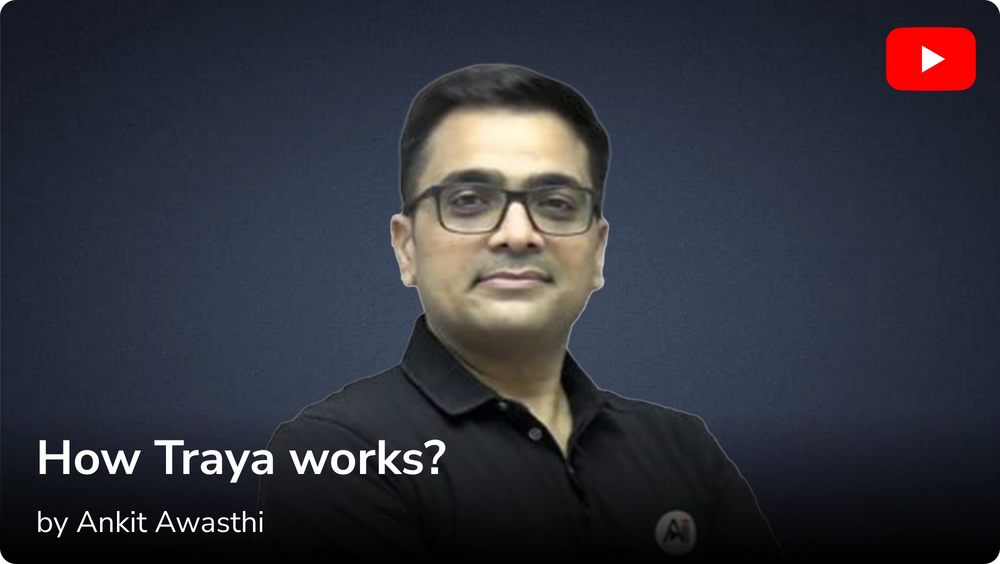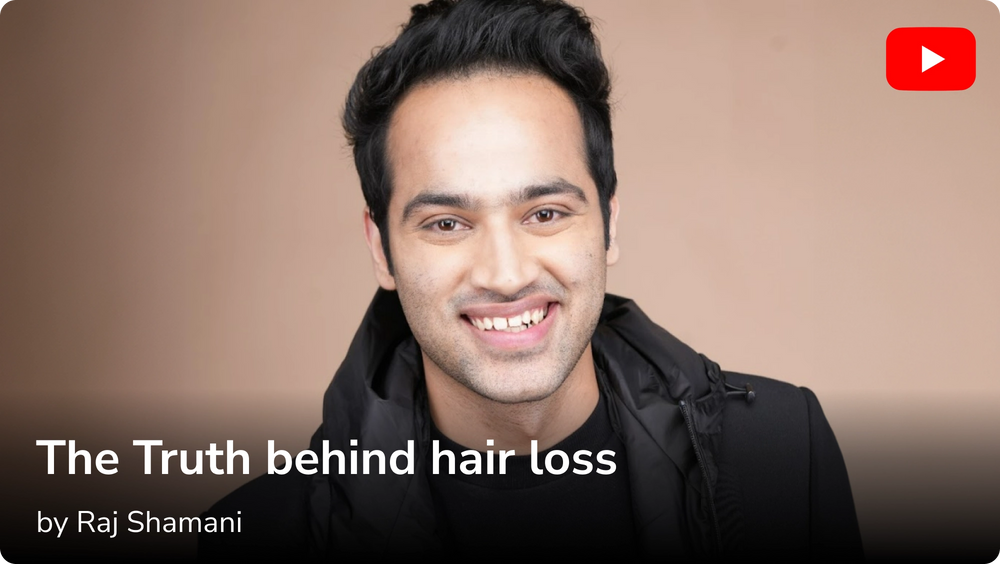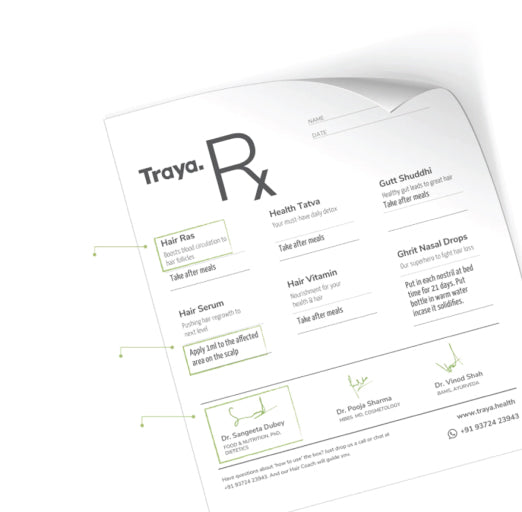Minoxidil is usually prescribed by doctors for hair growth, which is fine as long as there is supervision. But starting this treatment on your own is not generally advisable. It’s true that the solution is an OTC (over-the-counter) product and is made available easily, but determining whether you have a use for it or not is important.
Hair loss has become a nightmare to many people, and it can be hard to detect which treatment works and which doesn’t.
At Traya, we use minoxidil in some of our customized kits for our customers going through pattern hair loss (Androgenetic Alopecia), and we have seen in a lot of our patients that their hair loss mostly was either aggravated due to internal issues or incorrect use of topical solutions.
If you are here to know how minoxidil works, then do read ahead and make a choice that best suits your hair.
What is Minoxidil?
Minoxidil comes in oral (tablet) and topical (serum) forms. For hair, users are usually advised to opt for topical minoxidil as the oral form has a higher concentration of the compound and is typically used for heart-related issues.
Minoxidil is a vasodilator, which means that it helps dilate the blood vessels to make it easier for the blood to flow. While this medication was used orally for high blood pressure, researchers saw increased hair growth as a side effect.
This made Dr. Guinter Kahn curious along with his Colleague Paul J. Grant. They developed the solution Rogaine, which was the first ever FDA-approved minoxidil.
Many brands have now formulated Minoxidil and the demand has been increasing ever since, it’s important to know that the solution comes in 2% and 5% concentration and which one to use depends on the stage at which your hair loss is.
How Does Minoxidil Work?
Now coming to the point, Minoxidil works by increasing the blood flow to the hair follicles when applied topically, it helps in extending the anagen phase (growth phase) and shortening the telogen phase (resting phase) during the hair growth cycle.
When this process repeats over time, new and healthy hair can be seen after the initial shedding phase.
To break it down simply:
1. Widening Blood Vessels: Minoxidil works by widening the blood vessels which makes the blood flow towards the hair follicles better. With better blood flow, more nutrients and oxygen is given to the hair follicles which ultimately provides nourishment.
2. Activate Weak Hair Follicles: No medication can revive dead hair follicles, but if by any chance you have weak hair follicles, then minoxidil can certainly help to activate them by opening the potassium channels and increase the chances of hair growth.
3. Extend the Growth Phase (Anagen): According to the hair growth cycle, the Anagen phase goes up to 3-5 years, and for some people, even 7 years. Minoxidil helps to extend this phase, which means that your hair gets more time to stimulate and produce better and thicker hair.
4. Shortening the Resting Phase (Telogen): Minoxidil helps move hair follicles from the resting phase back to the growth phase more quickly. This means that less hair falls out and more hair starts growing.
Also Note:
Minoxidil’s process usually includes initial shedding also called “dread shed” which happens after applying minoxidil for 1-2 weeks and can go on for a month.
The shedding happens as the weak hair strands come out to make space for newer hair strands, hence do not be scared if you are experiencing this and make sure to call your hair care professional for more details.
How Long Does Minoxidil Take to Work?
Minoxidil is indeed popular for various reasons, especially its ability to show positive results. In various studies, Minoxidil has shown over 80% success, and hence, many dermatologists recommend using it. For minoxidil to show results, we have noticed that it can take anywhere from 3 months to 1 year to notice visible changes with consistent use.
3-6 months is usually the estimated timeline, but users with higher stages of hair loss might take slightly longer to stabilise before regrowth starts. Everyone has a different reason for hair loss, which is why the effectiveness of any medication or treatment varies from person to person. Some users report no visible change for months, but then, after a while, sudden improvements around month 5 or 6 are seen. Factors like sleep, nutrition, stress, and the use of heat styling can influence the response time.
Minoxidil Results Over Time
At Traya, we use Minoxidil as a part of some of our holistic kits for people after diagnosing their root cause of hair loss. With consistent use and all-around efforts, the ultimate results are 3X better and faster than using Minoxidil alone, according to a clinical study.
What users usually experience while applying minoxidil is that: In the first 3 months some users notice early signs of hair regrowth and new formed density in thinning areas. Even though results often vary, many people still see noticeable hair growth by this time.
By 6 months, the hair feels denser, thicker, and long enough to notice the difference, as the initial shedding phase ends and new hair starts to appear.
After a full year of consistent use, many users experience thicker and fuller hair, with minimal signs of hair loss. At this point, it is important not to abruptly stop using Minoxidil and only do so after consulting with your hair care professional.
Tracking Progress
To know if minoxidil is working for you, it's essential to keep track of your progress. Regularly taking photos helps document changes over time and allows you to see improvements that might not be immediately noticeable. Also, consulting with a hair care professional can provide a better understanding of the course and ensure you’re using the treatment correctly.
If not photos, another way to track progress is scalp mapping. You can mark specific thinning areas and observe how they fill in over time. Some people also use hair part width as an indicator; if your part starts appearing narrower over time, it's a subtle sign of progress.
Traya App’s scalp tracking feature is made specifically for this use, once you see the before and after results from treatment, it’ll make you understand better if the treatment suits you or not.
Also read: Minoxidil Results - Before and After
How to Get Better Results From Minoxidil
Minoxidil shows its effectiveness to many people, but what about the ones who are trying and testing every other treatment but fail to get results?
Actually, this is what Traya had noticed in multiple customers. The studies have shown us that most people experiencing hair loss have an underlying issue which resulted in hair loss as a symptom.
And the same goes for minoxidil, it can initially help for hair regrowth but if the root cause is not detected and treated then there is a high chance for the hair loss to resurface.
Here’s what you can do for minoxidil to work effectively:
-
You can use a derma roller once a week to increase the ability of the scalp to absorb topical minoxidil.
-
You can apply minoxidil at the same time daily to train your scalp into having a structured and focused period.
-
If you want to apply oils then make sure to apply them at a different time of day than minoxidil. (e.g., morning oil, evening minoxidil) to avoid mixing the two products.
Tips for Application and Consistency
-
Maintain Consistency: Use Minoxidil the way your hair care professional has mentioned, it is usually applied twice a day, 1ml each time. Please make a note that only after consistent use, you’ll be able to see the result.
-
Keep your scalp dry: To avoid mixing products, apply minoxidil only to a clean and dry scalp. This will ensure that the medication is fully absorbed and can work effectively.
-
Do Not Overuse: It is important to apply only the recommended amount. Using more than the suggested dosage doesn’t speed up results and can increase the risk of side effects.
-
Do not wash immediately: Allow Minoxidil to dry completely before touching your hair or scalp. Avoid washing your scalp for at least 4 hours after application to ensure that the serum is completely absorbed.
Complementary Treatments
These are some of the medications and treatments that you can use along with Minoxidil for gaining maximum results.
Finasteride
Studies have shown that combining minoxidil with finasteride increases its efficacy. Finasteride also comes in topical formulation which reduces DHT levels (DHT is a hormone which primarily affects hair loss, stabilizing this hormone can help with hair regrowth.)
Traya’s Holistic Treatment Plan
Traya can help you know the kind of treatment you require. If we include minoxidil to your treatment then along with it we prescribe Ayurvedic supplements, nutritious diets, professional help, and recommend shampoos and oils that will help you with an all rounded treatment to eliminate the root cause of your hair problems.
Take Traya’s Free Hair Test Today, and know your root cause before starting your journey towards healthy hair!
Lifestyle Changes and Dietary Supplements
Most of the physical problems, especially related to appearances stem from dietary and lifestyle choices. Here are some of the changes you can make to your diet and lifestyle that can positively affect hair health.
-
Having a Healthy Diet: Having a diet rich in vitamins and minerals supports overall hair health. Include foods high in iron, zinc, and vitamins A, C, and E, which are beneficial for hair growth.
-
Manage Stress: High stress levels can increase hair loss. It is best to practice stress-reducing activities like exercise, meditation, or hobbies to help maintain healthy hair.
-
Dietary Supplements: Consider supplements like biotin, omega-3 fatty acids, and vitamin D, which can support hair health. Try taking a blood test and see if you have any vitamin deficiency, so that your doctor can prescribe you the supplements to ensure they are appropriate for you.
It is seen that Vitamin D deficiency is common in people with hair loss, along with biotin and iron (if levels are low). Having the supplements for any deficiency can help with energy levels, sleep patterns, and hair health. Even exercise helps regulate insulin and cortisol, both of which indirectly support follicular activity.
Using these methods can make a lasting impact on your hair health journey, the best way to recognise what works for you it to understand your underlying problems, it is best to have yourself checked and work on the problems accordingly.
Potential Side Effects and How to Manage Them
While Minoxidil is an effective solution for most people, there are still some side effects that must be kept in mind before using it. The most common complaints that we have noticed are itching and dryness of scalp.
This can be resolved by using a hydrating, alcohol-free scalp serum. Some users switch to foam to reduce contact time with the scalp, and always patch test new versions, especially if you have a sensitive or acne-prone scalp.
Let’s look into some side effects that can be caused by Minoxidil:
1. Scalp Irritation
2. Itching
3. Headache
These side effects are quite common when minoxidil is applied. While you don’t have to worry as these symptoms will subside over time, it is better to contact a doctor if the pain becomes insufferable. Usually, it doesn’t get to that point, but it is better to be cautious.
You can check out: Truths and Myths About Minoxidil, where top dermatologists discuss what to expect and what not to expect from Minoxidil.
If we look into rare side effects, then you must note that these side effects are termed rare because to date, there haven’t been such drastic side effects caused by minoxidil, but this medication, being a vasodilator, has its own properties and it is always best to be aware.
In rare cases, minoxidil can lead to lightheadedness or increased heart rate. These side effects usually occur if large quantities are absorbed regularly or if it is combined with certain blood pressure medications. Always consult a doctor if you have a medical history, especially related to heart conditions.
How Can Traya Help You?
Traya has conducted studies with over 5 Lakh Men and 2 Lakh Women dealing with Hair loss. The problem we identified was the affordability, efficacy, and sustainability of the treatments.
There is always an era of a hero product in the market, call it onions, aloe vera, and recently rosemary. While these ingredients can be useful for hair growth but is it really possible for 1 ingredient to help with issues like nutritional deficiency, hormonal imbalance, patterned baldness, or thyroid?
So, what is the solution?
We can provide a way to find your root cause of the problem through our Free hair test. This will help our doctors understand your underlying issues and prescribe you medications accordingly.
You will then have a choice to continue the treatment with us after ordering the kit. Every kit lasts for a month and costs around 1500 Rs - 3000 Rs / Month.
You can start seeing results after 3-4 months of consistent use, and if the results are not seen, then you can always apply for the money back guarantee policy.
Stress is one of the major causes of hair loss, so keep your stress OVER hair loss away and join us today to reach your hair health goals.
People Also Ask
Q. Can Minoxidil Cause Grey Hair?
Studies have shown that Minoxidil can cause discoloration of hair mainly if you have a history of early hair greying in family. Rest, it is not a common symptom so you don’t have to worry and only use the medication when recommended by your doctor.
Q. Does Minoxidil Regrow Hair?
Yes, Minoxidil does help in regrowing hair. The only condition for it to work is that the hair follicles must not be completely dead; if the hair follicles are weak, then they can be easily reactivated with continuous use.
Q. Can I stop using Minoxidil once I see results?
Minoxidil is a treatment that has to be used for a long time for the effects to show and sustain. Abruptly stopping the treatment can lead to hair loss all over again, so always be mindful before starting the treatment and stopping it.
Q. Are there any long-term risks associated with Minoxidil use?
Minoxidil is generally safe for long-term use, but some users may experience ongoing side effects such as scalp irritation or unwanted hair growth in nearby areas where it is applied.
References
Minoxidil: mechanisms of action on hair growth | https://pubmed.ncbi.nlm.nih.gov/14996087/#:~:text=Minoxidil%20may%20also%20cause%20prolongation,indicate%20lines%20of%20future%20research.
Minoxidil topical (Rogaine) - Uses, Side Effects, and More | https://www.webmd.com/drugs/2/drug-3503/minoxidil-topical/details
Minoxidil | https://www.ncbi.nlm.nih.gov/books/NBK482378/
















